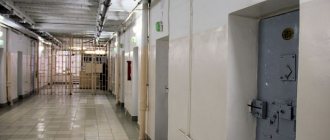A temporary detention center is required to isolate people dangerous to society who have committed some kind of crime.
An appropriate decision is required to determine imprisonment. Before the trial begins, the suspect is kept under guard to prevent him from escaping. This is why the Ministry of Internal Affairs needs a temporary detention facility (IVS).
In this article we will talk about the rules of detention in temporary detention centers in 2022, the basic conditions of stay in a given place, who is kept in them and the transfer of necessary things.
What is a temporary detention facility in the police?
Such detention centers hold detainees in whose case a decision and punishment have not yet been made.
In addition to persons under investigation, temporary detention facilities may also contain other categories of citizens:
- persons who have been transferred from a pre-trial detention center for the duration of investigative work, if daily transportation of the prisoner from a remote place of detention is not possible;
- persons serving a 15-day administrative sentence.
Many people confuse temporary detention centers with pre-trial detention centers. In fact, both of these objects are places for isolating dangerous individuals from the rest of society. But each of them has its own conditions of detention, so it is necessary to understand how a temporary detention center differs from a pre-trial detention center.
The temporary detention facility consists of several cells located directly at the police station . A pre-trial detention center is a separate facility that is part of the law enforcement system. Previously, temporary detention centers were called bullpen cells.
The number of people isolated in these institutions also varies . Temporary detention centers contain persons who are still only suspected of committing a crime, i.e. they have not yet been taken into custody.
The pre-trial detention center houses subjects who are under investigation, as well as convicts whose case is undergoing trial.
What is a temporary detention facility?
Isolators of this kind are intended to hold detainees for whom a preventive measure has not been chosen, which means their placement in an institution designed to isolate persons under investigation is unacceptable. In addition to citizens detained for various reasons, the temporary detention center contains:
- those who are ordered to serve an administrative sentence within 15 days;
- transferred from a pre-trial detention center for the period of investigative measures, if its placement is remote and daily travel is not justified.
This video tells about the peculiarities of serving in a temporary detention facility:
Duration of detention in a temporary detention facility
For the first time, a person can be placed in a temporary detention center for no more than two days. The period begins to count as soon as the detainee has been delivered to the investigator or interrogating officer.
After this time has expired, the following actions must be performed:
- Issuance by the court of punishment in the form of arrest and transfer of the detainee to a pre-trial detention center.
- Extension of the isolation period by 3 days, but so that the total duration does not exceed 120 hours. Such a decision can be made by the judiciary.
- Release of the suspect.
The maximum period of stay of a detainee in a temporary detention facility transferred from a pre-trial detention center can be 10 days per month. But at the same time, it is possible for him to stay in the isolation ward for 20 days, but this period must be continuous and be for two months.
For this purpose, two translations are prepared:
- The first transfer occurs at the end of the month. Moreover, the last day of this transfer must coincide with the last day of the month.
- The second translation begins immediately after the first, i.e. the first day of this transfer must correspond to the first day of the month that begins next.
Length of stay
A detainee can remain in a temporary holding facility (TDF) for no more than 48 hours. An accused person put on the wanted list and subsequently discovered may also be placed in a temporary detention facility. Detention begins from the moment when a person is deprived of the right to dispose of himself; the period itself is counted from the time of delivery to the interrogating officer or investigator and cannot exceed 2 days. After its expiration, the suspect must be sent to a pre-trial detention center, arrested or released; in addition, the court can extend the period of stay in the temporary detention center by a maximum of 72 hours. During the arrest, a protocol is drawn up, which must be signed by the suspect and the person who compiled it.
It is worth noting that a bullpen is also a cell where persons against whom a preventive measure such as detention can be kept. This happens in cases where investigative actions are carried out outside populated areas where there are pre-trial detention centers. The maximum period of stay in them in this case is limited to ten days per month.
Rules for detention in a temporary detention facility
The detention in a temporary detention center, which belongs to the Ministry of Internal Affairs, is of a prison nature. Arrested persons must be kept in closed cells, most of which have only a sleeping area and no sanitary facilities.
Since people stay in temporary detention centers for a short period of time, walks and any leisure activities are available only if there are special premises.
The conditions of detention in the temporary detention center are very strict. This is necessary in order to prevent the people there from colluding and escaping.
Therefore, detainees cannot move unaccompanied, and at night the cells must be illuminated.
General standards
The main reason why police temporary detention cells are overcrowded is the limited number of places. The influx of arrests is especially observed on weekends and holidays. Temporary detention centers vary in size.
Medium and large objects can be located in separate buildings or basements, so they are usually equipped according to all the rules:
- a sufficient number of sleeping places and seats at the table;
- washing supplies and sanitary equipment;
- basins for washing clothes and cabinets for storing them;
- day and night lighting devices;
- supply and exhaust ventilation;
- container with drinking water;
- duty call button, radio speaker, etc.
The rules for keeping detainees in temporary detention facilities also require the issuance of such accessories as:
- laundry soap;
- toilet paper;
- equipment for putting things in order in the cell;
- Board games;
- printed publications (if the administration allocates funds for its purchase).
Compliance with the law in temporary detention centers is carried out with the help of prosecutorial supervision.
Main purpose of the insulator
The temporary detention facility, as a police institution, is required to protect dangerous criminals from society.
To determine the perpetrators to prison, a special official decision is required. Before receiving it, the suspect must be under reliable escort. The offender must not cause harm and must not be able to escape. For this purpose, a modern insulator is needed.
Below you will find information about what a temporary detention facility is, what rules exist for staying in it, who enters the temporary detention facility, and how to deliver food parcels to prisoners.
Admission to the temporary detention facility
Prisoners are continuously admitted to the temporary detention center, regardless of the time of day or day of the week. The initial examination includes interviewing applicants to determine their identity and testimony, as well as checking accompanying documentation.
If there are bodily injuries, a special report must be drawn up, which indicates the severity and nature of the injuries. If medical care is necessary, the detainee, accompanied by employees of the Ministry of Internal Affairs, is hospitalized in a hospital.
During admission to the isolation ward, several mandatory procedures are performed:
- fingerprinting;
- personal search of the detainee himself, as well as his belongings and clothing;
- photographing.
During a personal inspection of things, police officers have the right to rip open clothes and take apart shoes.
In addition, a thorough examination of dressings, plaster and prostheses can be carried out, as well as internal cavities can be examined for the presence of foreign objects.
The detainees' belongings must be disinfected, and the detainees themselves must be washed in a shower or bath. The only exceptions are persons suffering from head lice. They are sent for sanitary treatment.
Temporary detention center internal regulations
Most of the time, prisoners are in temporary detention cells. They leave them only for several reasons:
- Daily walks in a special room or on the territory. The duration of such a walk is from 2 hours for teenagers and from 1 hour for adults. At the request of the prisoner, it can be interrupted earlier than the allotted time.
- Meetings with a lawyer lasting from 2 hours. They are possible every day.
- Communication with family members and loved ones with appropriate permission from the investigative authorities. Occurs up to 2 times a month. Their maximum duration is 3 hours.
- Water procedures for hygiene (bath or hot shower) are allowed every week.
- To conduct investigative activities, meetings with the investigator or inquiry officer, and other procedures required to conduct the case.
- To study with guest teachers of juvenile prisoners.
Content mode
The operating rules of the temporary detention center regulate contraindications for the detention of certain categories of detainees in order to respect their rights.
We are talking about the following subjects:
- prisoners of different sexes;
- adults and teenagers (with the exception of those detained for the first time for non-serious violations);
- criminals and internal government officials;
- repeat offenders and first-time detainees;
- persons against whom a conviction has already been made, and simply suspects;
- defendants in related or one and the same case.
Subjects who are involved in a criminal case as suspected of committing several serious offenses must also be kept separately from all other categories of detainees.
Even mothers with infants can stay in temporary detention facilities, but this requires a decision from the prosecutor and documentary confirmation of the relationship between the woman and the child.
Hygiene products and a baby cot are provided for this category. In addition, they are usually kept separately from other detainees.
The need to stay in the bullpen
A person who has committed a crime is isolated from society and placed in appropriate correctional institutions. Until this moment, the investigative and search authorities carry out a large amount of work in order to then transfer the case to the court, which must issue a decision on the arrest or, conversely, the release of the detainee. All the time that will be spent on such events, the person suspected of a crime must be kept under guard. For this reason, you can end up in the bullpen, because they are created for this very purpose. It is worth noting that the cells may also contain those who are serving an administrative sentence within 15 days.
Parcels for detainees in temporary detention facilities
To receive things needed in everyday life and for personal needs, detainees can use parcels. But first you should familiarize yourself with the rules of what can be transferred to a temporary detention center, since there are certain conditions for this.
The arrested person can receive an unlimited number of parcels, but their total weight must not exceed 30 kg. Also, they should not contain prohibited items.
Restrictions on the total weight of transferred items do not apply to three categories of detainees:
- Pregnant women or mothers with infants;
- Minors;
- Subjects with serious illnesses, the presence of which is confirmed by a medical certificate.
Detainees who have not yet turned 18 years of age are also allowed to receive textbooks, office supplies, and literary publications required for their studies through donations.
Printed publications that are permitted for transmission must be in the public domain. They are weighed and inspected in the acceptance room.
But there are also restrictions on parcels for the following cases and categories of detainees:
- Subjects who, due to their behavior, were placed in a punishment cell. The ban on transfers is valid until the end of the punishment and return to the cell.
- At meetings with a lawyer and relatives, any transfers are prohibited, otherwise the meeting ends ahead of schedule.
- Transfers from one camera to another.
- Transfers between persons who have been convicted of prohibited or counterfeit items.
Rules for sending and receiving parcels
To receive personal or household items, the temporary detention center provides the opportunity to transfer parcels. These operations are carried out exclusively in accordance with certain rules.
Each person arrested has the opportunity to receive more than one parcel, the main thing is that the total weight does not exceed 30 kg. This restriction does not apply to three categories of people:
- Pregnant women and mothers of babies.
- Teenagers who have not reached the age of majority.
- Persons with serious illnesses. This must be confirmed by a special medical certificate.
Parcels must not contain items prohibited by law.
Some people shouldn't accept packages at all. These are the following categories of persons:
- Redirected to a punishment cell for misconduct and violation of established rules.
- Those on a date or meeting with personal lawyers.
- Persons convicted of trafficking in prohibited items.
Parcels are received from relatives and friends in a special room, where they are carefully inspected and weighed.









